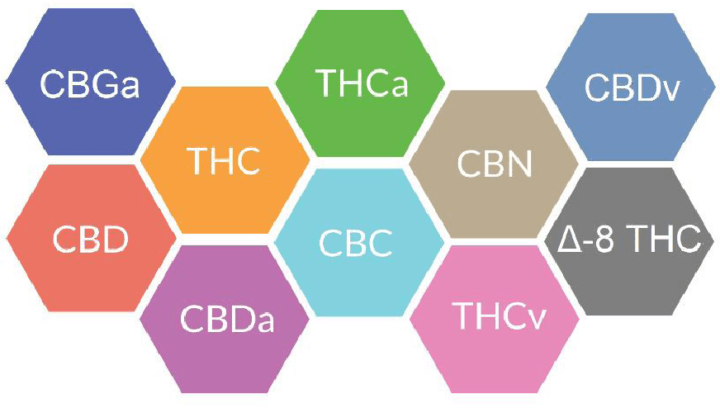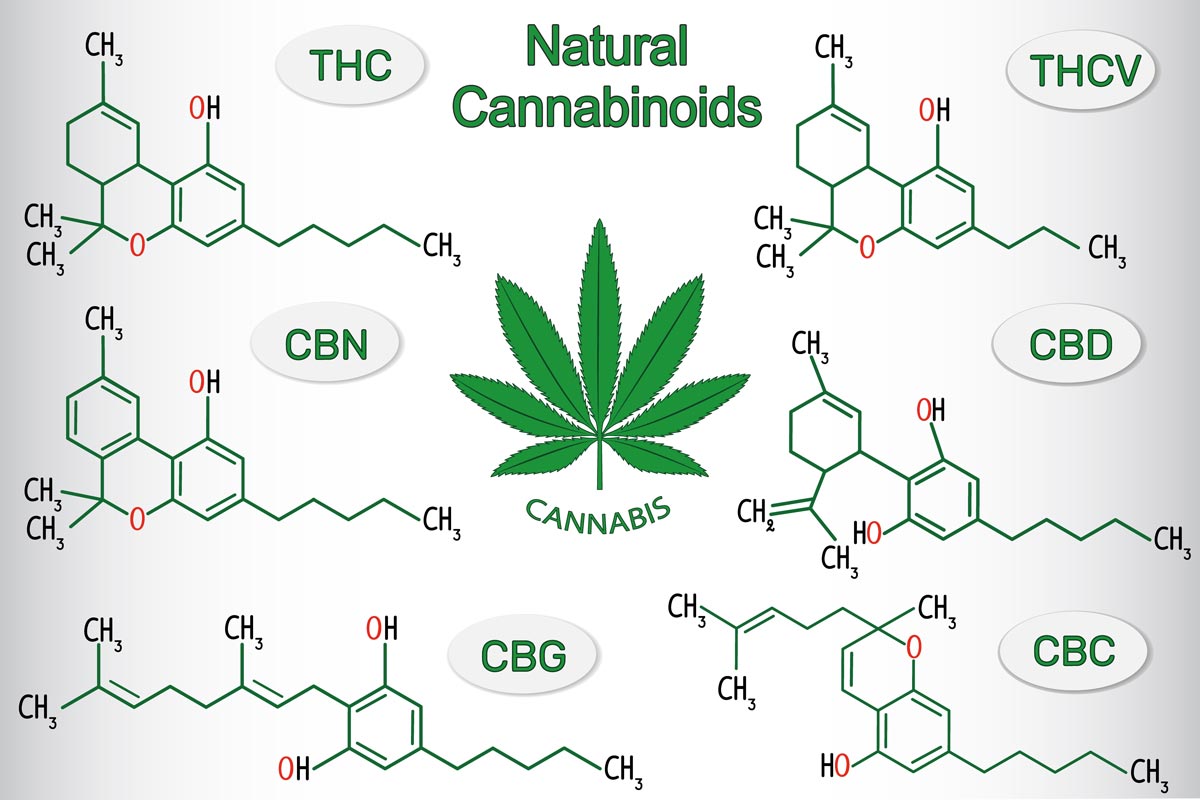- Admin Admin
- Olejki cbd
- 0 likes
- 8556 views

The translation is automatic, therefore we are not responsible for possible errors.
Cannabinoids are chemicals that activate the cannabinoid receptors found in the human body. Plant cannabinoids are naturally occurring compounds that are found in high concentrations in female cannabis inflorescences, and more specifically in the resin glands found on the surface of flowers. So far, about 85 different cannabinoids found in different strains of cannabis have been identified, each of which has a different effect on the cannabinoid receptors found in the human body.
These acidtrahydrocannabinol (THC-A)
Formula: C 22H.thirtyABOUT4
Molecular weight: 358.4733 g / mol
Boiling point: 105 ° C
Tetrahydrocannabinolic acid, like other cannabinoid acids, is not a psychoactive substance. THC-A is a potent anti-inflammatory, anti-cancer, appetite-enhancing, anti-insomnia and antispasmodic substance. THC-A is the most common terpenoid (and cannabinoid) in many varieties: //vaporshop.pl/pl/16-z-konopi ">hempgrown in the USA, the content of which can be up to 30% of the dry weight of female seedless inflorescences. Many high-THC varieties grown under the right conditions can contain up to 15% of THC-A by dry weight, with the amount varying with the variety.
Acid kannabidiol (CBD-A)
Formula: C 22 H 30 O 4
Molecular weight: 358,2144 g / mol
Burning temperature:> 120 ° C
Until recently, wild cannabis was considered the main source of cannabidiolic acid. Thanks to the hybridization technique, cannabis varieties have been obtained that produce more CBD-A compared to THC-A. Cannabidiol acid has anti-inflammatory and anti-cancer properties.
Cannabichromic acid (CBC-A)
Formula: C 22 H 30 O 4
Molecular weight: 358.2144 g / mol
Burning temperature:> 120 ° C
Cannabichromic acid is one of the three compounds that cannabis produces from CBG-A (cannabigerolic acid). CBC-A has an anti-inflammatory effect. It is a strong antibacterial compound and a weak antifungal compound.
Cannabigerolic acid (CBG-A)
Formula: C 22 H 30 O 4
Molecular weight: 360.48708 g / mol
Burning temperature: unknown
Cannabigerolic acid is considered to be the starting compound from which other cannabinoids are formed as a result of plant biochemical changes. In addition to the interactions specific to all cannabinoids, it is also a starting compound for the production of CBG, a rare compound ofhaving a regenerative effect on the nervous system.
Delta-9-tetrahydrocannabinol (∆-9-THC)
Formula: C 21H.thirtyABOUT2
Molecular weight: 314.2246 g / mol
Boiling point: 157 ° C
Δ-9-tetrahydrocannabinol (commonly referred to as "Δ9-THC," "D9-THC," "d9-THC" or simply "THC") is an inert cannabinoid known for its potent psychoactive effects. Of all the scientific facts about THC, the most important thing seems to be that THC helped discover the existence and role of the endocannabinoid system in vertebrates (including humans). THC is an effective remedy for various ailments and diseases, including pain, nausea , cancer and ADHD.
Cannabidiol(CBD)
Formula: C 21H.thirtyABOUT2
Molecular weight: 314.2246 g / mol
Boiling point: 180 ° C
Cannabidiol is a non-psychoactive compound (it does not induce euphoria, changes in the perception of time passing, or anxiety that THC normally causes), but its pharmacological effects are used to treat seizure disorders such as multiple sclerosis and epilepsy. The lack of psychoactive effects means that CBD can be used to treat children, the elderly and people who are disturbed by the effects ofnot psychoactive THC. The effectiveness of CBD is similar to THC. It is used in the treatment of pain and cancer. Additionally, CBD has been shown to lower blood sugar and can be used to treat diabetes, and has a sedative effect, allowing it to be used to treat stress-induced disorders and to treat insomnia.

Kannabichromen (CBC)
Formula: C 21H.thirtyABOUT2
Molecular weight: 314.2246 g / mol
Boiling point: 220 ° C (428 ° F)
Cannabichromene is a non-psychoactive compound. It is ten times more effective in treating anxiety and stress than CBD. It also has anti-inflammatory, analgesic, antiviral and anti-cancer effects. CBC has been shown to stimulate bone growth.
Cannabigerol (CBG)
Formula: C 21H.thirtyABOUT2
Molecular weight: 314.2246 g / mol
Boiling point: unknown
Cannabigerol is a non-psychoactive compound that stimulates the growth of new nerve cells, including in the elderly. Worth afteremphasize that factors that stimulate the growth of nerve cells are extremely rare. CBG stimulates bone growth and has antibacterial and anti-cancer properties, and helps fight insomnia.
Cannabinoid acid (CBN-A)
Formula: C 22H.31ABOUT4
Molecular weight: 359.48 g / mol
Burning temperature: unknown
Cannabinolic acid is the starting compound that is converted into cannabinol (CBN) by the decarboxylation process. Interestingly, in plants, the main source of CBN is the oxidation of THC, as there is too little cannabinoic acid in plants to be of importance for CBN production. Cannabinoid acid has anti-inflammatory and generally antibiotic effects.
Cannabinol (CBN)
Formula: C 21H.26ABOUT2
Molecular weight: 310.1933 g / mol
Boiling point: 185 ° C
Cannabinol is a product of the oxidation of THC, which is produced when THC is exposed to oxygen and high temperatures. A high concentration of CBN is found in mature cannabis that has been exposed to high temperatures. CBN has a weak psychoactive effect and a stronger sedative effect than other cannabinoids. Therefore, varieties with a high concentration of CBN (approx. 1% by weight) are used in the treatment of insomnia.. CBN also has antiemetic and anticonvulsant effects.

Delta-8-tetrahydrocannabinol (∆-8-THC)
Formula: C 21H.thirtyABOUT2
Molecular weight: 314.4617 g / mol
Combustion temperature: unknown
"Delta-8-tetrahydrocannabinol is a tetrahydrocannabinol (THC) analog with anti-emetic, anxiolytic, appetite-stimulating, analgesic and nervous system protective effects. Delta-8-tetrahydrocannabinol (delta-8-THC) binds to the cannabinoid G protein linked to the CB1 receptor , which inhibits adenylate cyclase and activates MAP kinases, regulates the function of potassium channels and inhibits some types (N- and P / Q-) of calcium channels. . " - NiH.gov
Cannabicyclic acid (CBL-A)
Pattern: unknown
Molecular weight: unknown
Burning temperature: unknown
Little is known about this compound as the amount produced by plants is negligible. The only certainty is that of all cannabinoid acids, it is the most resistant to the decarboxylation processwhich means that it is obtained in trace amounts during combustion. Cannabicyclic acid has anti-inflammatory and anti-cancer properties.
Cannabicyclol (CBL)
Pattern: unknown
Molecular weight: unknown
Combustion temperature: unknown
Cannabicycol is a product of cannabichrome breakdown when exposed to light. The therapeutic effect of this compound is unknown due to the low concentrations found in plants.
Cannabinoids. Steep Hill, www.steephill.com/science/cannabinoids; accessed on: June 21, 2018

